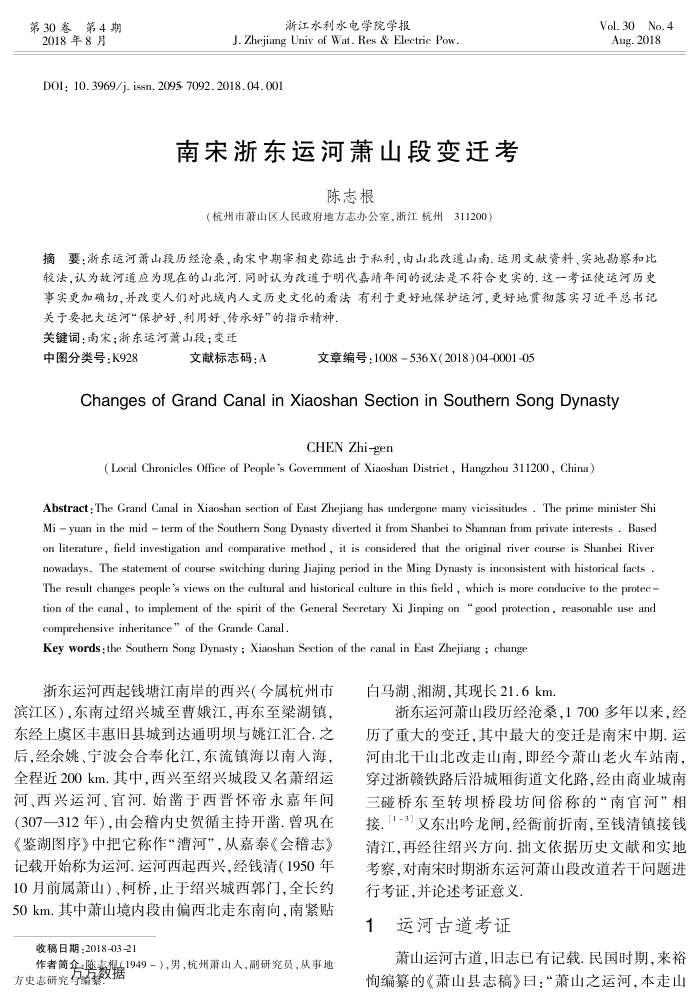您当前的位置:首页>论文资料>南宋浙东运河萧山段变迁考
内容简介
 第30卷第4期 2018年8月
第30卷第4期 2018年8月浙江水利水电学院学报
J. Zhejiang Univ of Wat. Res & Electric Pow.
D0I: 10.3969/j. issn.2095 7092.2018.04.001
南宋浙东运河萧山段变迁考
陈志根
(杭州市萧山区人民政府地方志办公室,浙江杭州311200)
Vol. 30No.4 Aug.2018
摘要:浙东运河萧山段历经沧桑,南宋中期宰相史弥远出于私利,由山北改道山南.运用文献资料、实地勘察和比较法,认为故河道应为现在的山北河.同时认为改道于明代嘉靖年间的说法是不符合史实的.这一考证使运河历史事实更加确切,并改变人们对此域内人文历史文化的看法有利于更好地保护运河,更好地贯彻落实习近平总书记
关于要把大运河“保护好、利用好、传承好”的指示精神。关键词:南宋;浙东运河萧山段:变迁
中图分类号:K928
文献标志码:A
文章编号:1008536X(2018)04-0001-05
ChangesofGrandCanalinXiaoshanSectioninSouthernSongDynasty
CHEN Zhi-gen
(Local Chronicles Office of People 's Government of Xiaoshan District , Hangzhou 311200, China)
Abstract: The Grand Canal in Xiaoshan section of East Zhejiang has undergone many vicissitudes . The prime minister Shi Mi yuan in the mid term of the Southern Song Dynasty diverted it from Shanbei to Shannan from private interests . Based on literature, field investigation and comparative method , it is considered that the original river course is Shanbei River nowadays. The statement of course switching during Jiajing period in the Ming Dynasty is inconsistent with historical facts . The result changes people's views on the cultural and historical culture in this field , which is more conducive to the protec -tion of the canal , to implement of the spirit of the General Secretary Xi Jinping on “ good protection , reasonable use and comprehensive inheritance" of the Grande Canal.
Key words ; the Southern Song Dynasty ; Xiaoshan Section of the canal in East Zhejiang ; change
浙东运河西起钱塘江南岸的西兴(今属杭州市
滨江区),东南过绍兴城全曹娥江,再东全梁湖镇,东经上虞区丰惠旧县城到达通明坝与姚江汇合.之后,经余姚、宁波会合奉化江,东流镇海以南人海,全程近200km.其中,西兴至绍兴城段又名萧绍运河、西兴运河、官河.始凿于西晋怀帝永嘉年间(307一312年),由会稽内史贺循主持开凿.曾巩在《鉴湖图序》中把它称作“漕河",从嘉泰《会稽志》记载开始称为运泪,运润西起西兴,经钱清(1950年 10月前属肃山)、和桥,正于绍兴城西郭广,全长约 50km.其中萧山境内段由偏西北走东南向,南紧贴
收稿日期:2018-03-21
作者简数耀1949-),男,杭州萧山人,副研究员,从事地方史志研究孕数据
白马湖、湘湖,其现长21.6km
浙东运河萧山段历经沧柔桑,1700多年以来,经历了重大的变迁,其中最大的变迁是南荣中期.运河由北干山北改走山南,即经今萧山老火车站南、穿过浙赣铁路后沿城厢街道文化路,经由商业城南三碰桥东至转坝桥段坊间俗称的“南官河”相接.1-3又东出吟龙闸,经衙前折南,至钱清镇接钱清江,再经往绍兴方向.拙文依据历史文献和实地考察,对南宋时期浙东运河萧山段改道若干间题进
行考证,并论述考证意义 1运河古道考证
萧山运河古道,旧志已有记载.民国时期,来裕恂编繁的《萧山县志稿》:“萧山之运河,本走山
上一章:陕西关中古六辅渠位置考
下一章:太湖防洪设计水位对长兴平原回水影响及应对